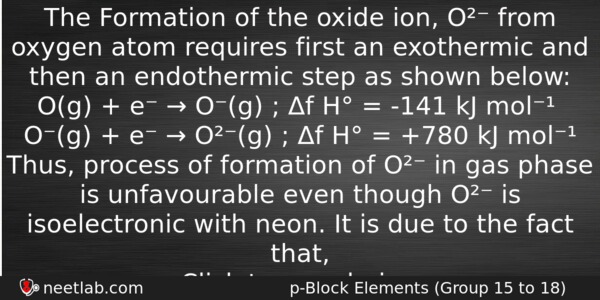| ⇦ | 
| ⇨ |
The Formation of the oxide ion, O²⁻ from oxygen atom requires first an exothermic and then an endothermic step as shown below:
O(g) + e⁻ → O⁻(g) ; Δf H° = -141 kJ mol⁻¹
O⁻(g) + e⁻ → O²⁻(g) ; Δf H° = +780 kJ mol⁻¹
Thus, process of formation of O²⁻ in gas phase is unfavourable even though O²⁻ is isoelectronic with neon. It is due to the fact that,
Options
(a) O⁻ ion has comparatively smaller size than oxygen atom
(b) oxygen is more electronegative
(c) addition of electron in oxygen results in larger size of the ion
(d) electron repulsion outweighs the stability gained by achieving noble gas configuration
Correct Answer:
electron repulsion outweighs the stability gained by achieving noble gas configuration
Explanation:
No explanation available. Be the first to write the explanation for this question by commenting below.
Related Questions: - When river water meets sea water delta formation takes place. This is due to
- Primary alcohols can be prepared by the reaction of RMgx with
- If Avogadro number NA, is charged from 6.022 ˣ 10²³ mol⁻¹ to 6.022 ˣ 10²⁰ mol⁻¹
- The maximum number of molecules is present in
- Average molar kinetic energy of CO and N₂ at same temperature is
Topics: P Block Elements in Group 15
(89)
Subject: Chemistry
(2512)
Important MCQs Based on Medical Entrance Examinations To Improve Your NEET Score
- When river water meets sea water delta formation takes place. This is due to
- Primary alcohols can be prepared by the reaction of RMgx with
- If Avogadro number NA, is charged from 6.022 ˣ 10²³ mol⁻¹ to 6.022 ˣ 10²⁰ mol⁻¹
- The maximum number of molecules is present in
- Average molar kinetic energy of CO and N₂ at same temperature is
Topics: P Block Elements in Group 15 (89)
Subject: Chemistry (2512)
Important MCQs Based on Medical Entrance Examinations To Improve Your NEET Score
18000+ students are using NEETLab to improve their score. What about you?
Solve Previous Year MCQs, Mock Tests, Topicwise Practice Tests, Identify Weak Topics, Formula Flash cards and much more is available in NEETLab Android App to improve your NEET score.
Share this page with your friends

Leave a Reply